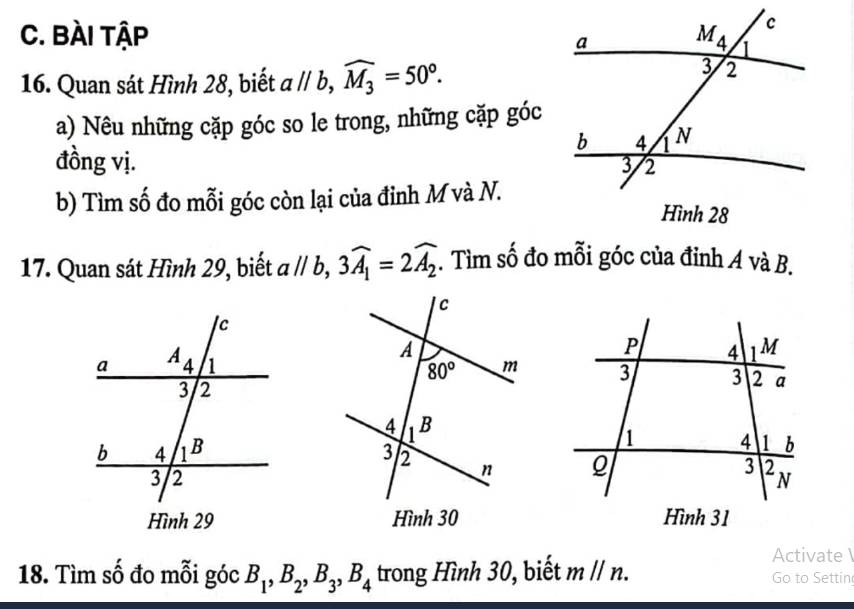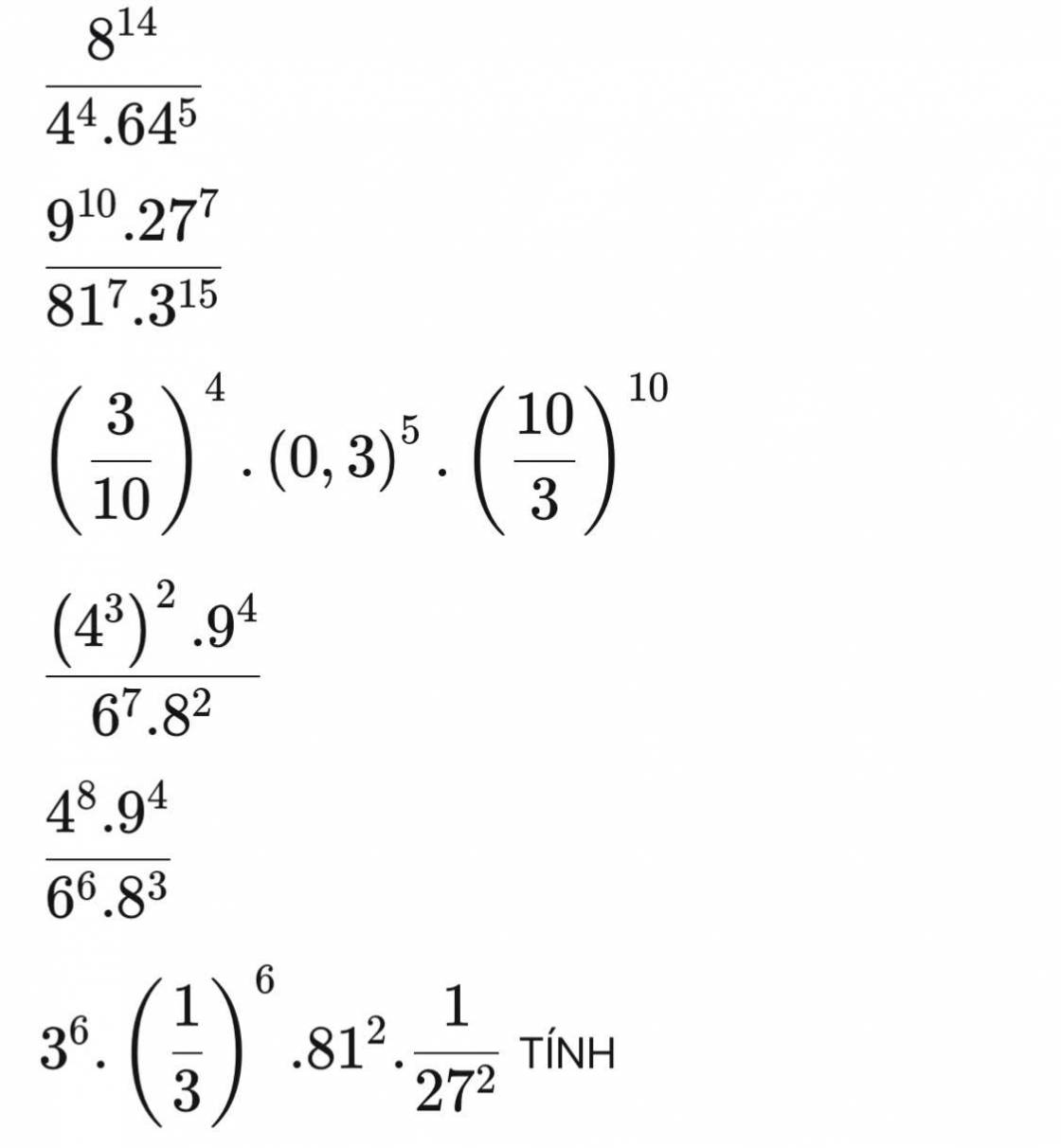Hãy nhập câu hỏi của bạn vào đây, nếu là tài khoản VIP, bạn sẽ được ưu tiên trả lời.

`@` `\text {Ans}`
`\downarrow`
`16,`
`@` Các cặp góc đồng vị:
`+`\(\widehat {M_4}\) và \(\widehat {N_4}\)
`+`\(\widehat {M_1}\) và \(\widehat {N_1}\)
`+`\(\widehat {M_2}\) và \(\widehat {N_2}\)
`+`\(\widehat {M_3}\) và \(\widehat {N_3}\)
`@` Các cặp góc sole trong:
`+`\(\widehat {M_3} \) và \(\widehat {N_1}\)
`+`\(\widehat {M_2}\) và \(\widehat {N_4}\)
`b,`
Ta có: \(\widehat {M_3} = \widehat {M_1} (\text {đối đỉnh})\)
`=>`\(\widehat {M_1}=50^0\)
\(\widehat {M_3}+\widehat {M_2}=180^0 (\text {kề bù})\)
`=>`\(50^0+\widehat {M_2}=180^0\)
`=>`\(\widehat {M_2}=180^0-50^0=130^0\)
\(\widehat {M_2}=\widehat {M_4} (\text {2 góc đối đỉnh})\)
`=>`\(\widehat {M_4} = 130^0\)
Vì \(\widehat {M_3}\) và \(\widehat {N_1}\) là `2` góc sole trong
`=>`\(\widehat {M_3}=\widehat {N_1}=50^0\)
\(\widehat {M_3}=\widehat {N_3}=50^0 (\text {2 góc đồng vị})\)
\(\widehat {M_2}=\widehat {N_2}=130^0 (\text {2 góc đồng vị})\)
\(\widehat {M_2}=\widehat {N_4}=130^0 (\text {2 góc slt})\)
`17,`
Vì \(\widehat {A_1}\) và \(\widehat {A_2}\) là `2` góc kề bù
`=>`\(\widehat {A_1}+\widehat {A_2}=180^0\)
\(3\widehat {A_1}=2\widehat {A_2}\) (gt)
`=>`\(\widehat{A_1}=\dfrac{2}{3}\cdot\widehat{A_2}\)
Thay \(\widehat{A_1}=\dfrac{2}{3}\widehat{A_2}\)
\(\dfrac{2}{3}\cdot\widehat{A_2}+\widehat{A_2}=180^0\)
`=>`\(\widehat{A_2}\left(\dfrac{2}{3}+1\right)=180^0\)
`=>`\(\widehat{A_2}\cdot\dfrac{5}{3}=180^0\)
`=>`\(\widehat{A_2}=180^0\div\dfrac{5}{3}\)
`=>`\(\widehat{A_2}=108^0\)
Vậy, số đo \(\widehat{A_2}=108^0\)
\(\widehat {A_1}+\widehat {A_2}=180^0 (\text {kề bù})\)
`=>`\(\widehat{A_1}+108^0=180^0\)
`=>`\(\widehat{A_1}=72^0\)
\(\widehat {A_1}=\widehat {A_3}=72^0 (\text {đối đỉnh})\)
\(\widehat {A_2}=\widehat {A_4}=108^0 (\text {đối đỉnh})\)
`@` Số đo các góc của đỉnh B:
`+`\(\widehat {A_4}=\widehat {B_4}=108^0 (\text {đồng vị})\)
`+`\(\widehat {A_2}=\widehat {B_2}=108^0 (\text {đồng vị})\)
`+`\(\widehat {A_3}=\widehat {B_1}=72^0 (\text {sole trong})\)
`+`\(\widehat {A_3}=\widehat {B_3}=72^0 (\text {đồng vị})\)

A = 1 + 2 + 22 + 23 + ...+ 2100
A\(\times\)2 = 2 + 22 + 23 +...+ 2100 + 2101
A \(\times\)2 - A = 2101 - 1
A = 2101 - 1

Đoạn 2x-1/3 là $\frac{2x-1}{3}$ hay $2x-\frac{1}{3}$ vậy bạn?

`@` `\text {Ans}`
`\downarrow`
\(\dfrac{8^{14}}{4^4\cdot64^5}\)
`=`\(\dfrac{2^{42}}{2^8\cdot2^{30}}\)
`=`\(\dfrac{2^{42}}{2^{38}}=2^4=16\)
\(\dfrac{9^{10}\cdot27^7}{81^7\cdot3^{15}}\)
`=`\(\dfrac{3^{20}\cdot3^{21}}{3^{28}\cdot3^{15}}\)
`=`\(\dfrac{3^{41}}{3^{43}}\)
`=`\(\dfrac{1}{3^2}=\dfrac{1}{9}\)
\(\left(\dfrac{3}{10}\right)^4\cdot\left(0,3\right)^5\cdot\left(\dfrac{10}{3}\right)^{10}\)
`=`\(\left(\dfrac{3}{10}\right)^4\cdot\left(\dfrac{3}{10}\right)^5\cdot\left(\dfrac{10}{3}\right)^{10}\)
`=`\(\left(\dfrac{3}{10}\right)^9\cdot\left(\dfrac{10}{3}\right)^{10}=\dfrac{10}{3}\)
\(\dfrac{\left(4^3\right)^2\cdot9^4}{6^7\cdot8^2}\)
`=`\(\dfrac{\left(2^6\right)^2\cdot3^8}{2^7\cdot3^7\cdot2^9}\)
`=`\(\dfrac{2^{12}\cdot3^8}{2^{16}\cdot3^7}\)
`=`\(\dfrac{3}{2^4}=\dfrac{3}{16}\)
\(\dfrac{4^8\cdot9^4}{6^6\cdot8^3}\)
`=`\(\dfrac{2^{16}\cdot3^8}{2^6\cdot3^6\cdot2^9}\)
`=`\(\dfrac{2^{16}\cdot3^8}{2^{15}\cdot3^6}=2\cdot3^2=18\)
\(3^6\cdot\left(\dfrac{1}{3}\right)^6\cdot81^2\cdot\dfrac{1}{27^2}\)
`=`\(\left(3\cdot\dfrac{1}{3}\right)^6\cdot\dfrac{81^2}{27^2}\)
`=`\(1^6\cdot\dfrac{3^8}{3^6}=1\cdot3^2=9\)
`\text {#KaizuulvG}`


\(\left(3x-5\right)\left(x+\dfrac{1}{2}\right)=0\)
\(\Rightarrow\left[{}\begin{matrix}3x-5=0\\x+\dfrac{1}{2}=0\end{matrix}\right.\)
\(\Rightarrow\left[{}\begin{matrix}3x=5\\x=-\dfrac{1}{2}\end{matrix}\right.\)
\(\Rightarrow\left[{}\begin{matrix}x=\dfrac{5}{3}\\x=-\dfrac{1}{2}\end{matrix}\right.\)
Vậy \(S=\left\{\dfrac{5}{3};-\dfrac{1}{2}\right\}\)

a) Theo đề f(x) nhận -2 là nghiệm lấy -2 thay vào x ta có:
\(\left(-2\right)^2-2m+2=0\)
\(\Rightarrow4-2m+2=0\)
\(\Rightarrow6-2m=0\)
\(\Rightarrow2m=6\)
\(\Rightarrow m=3\)
b) Tìm được m ta có: \(f\left(x\right)=x^2+3x+2\)
\(\Rightarrow x^2+3x+2=0\)
\(\Rightarrow x^2+2x+x+2=0\)
\(\Rightarrow x\left(x+2\right)+\left(x+2\right)=0\)
\(\Rightarrow\left(x+2\right)\left(x+1\right)=0\)
\(\Rightarrow\left[{}\begin{matrix}x+2=0\\x+1=0\end{matrix}\right.\)
\(\Rightarrow\left[{}\begin{matrix}x=-2\\x=-1\end{matrix}\right.\)
Vậy tập nghiệm của f(x) là: \(S=\left\{-2;-1\right\}\)



\(\dfrac{x+23}{2021}+\dfrac{x+22}{2022}+\dfrac{x+21}{2023}+\dfrac{x+20}{2024}=-4\)
Vì \(\dfrac{x+23}{2021}+\dfrac{x+22}{2022}+\dfrac{x+21}{2023}+\dfrac{x+20}{2024}=-4\)
\(\Rightarrow\dfrac{x+23}{2021}+\dfrac{x+22}{2022}+\dfrac{x+21}{2023}+\dfrac{x+20}{2024}+4=0\)
\(\Rightarrow\left(\dfrac{x+23}{2021}+1\right)+\left(\dfrac{x+22}{2022}+1\right)+\left(\dfrac{x+21}{2023}+1\right)+\left(\dfrac{x+20}{2024}+1\right)=0\)
\(\Rightarrow\dfrac{x+2044}{2021}+\dfrac{x+2044}{2022}+\dfrac{x+2044}{2023}+\dfrac{x+2044}{2024}=0\)
\(\Rightarrow\left(x+2044\right)\left(\dfrac{1}{2021}+\dfrac{1}{2022}+\dfrac{1}{2023}+\dfrac{1}{2024}\right)=0\)
\(\Rightarrow x+2044=0\left(\dfrac{1}{2021}+\dfrac{1}{2022}+\dfrac{1}{2023}+\dfrac{1}{2024}\ne0\right)\)
\(\Rightarrow x=-2024\)